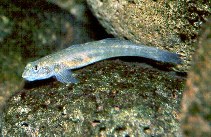| Family: |
Gobiidae (Gobies), subfamily: Sicydiinae |
| Max. size: |
7 cm SL (male/unsexed); 6 cm SL (female) |
| Environment: |
benthopelagic; freshwater; brackish; depth range 1 - 914 m, amphidromous |
| Distribution: |
Oceania: known only from Hawaii. |
| Diagnosis: |
Males displaying aggression or courtship behavior have the anterior half of their body velvety black, the posterior half bright reddish-orange and the fins whitish in color. Otherwise, both males and females are olive to brown, with only traces of two-tone color in the males. Both sexes with bright blue eyes. |
| Biology: |
Found in middle to upper reaches of (mountain) streams (Ref. 44091, 58302); known for its climbing abilities: found above 'Akaka Falls (>130 m high) on Big Island (Ref. 44091). Benthic (Ref. 58302). Used for food in Moloka'i and Maui; caught by suspending a baited ipu, or gourd, in midwater, attached to the end of a stout pole; considered a symbol of bad luck in other areas and discarded when caught (Ref. 44091). Max. length (Keoki Stender, pers. comm., 1999). |
| IUCN Red List Status: |
Data deficient (DD); Date assessed: 01 August 1996 Ref. (130435)
|
| Threat to humans: |
harmless |
| Country info: |
|
Source and more info: www.fishbase.org. For personal, classroom, and other internal use only. Not for publication.

